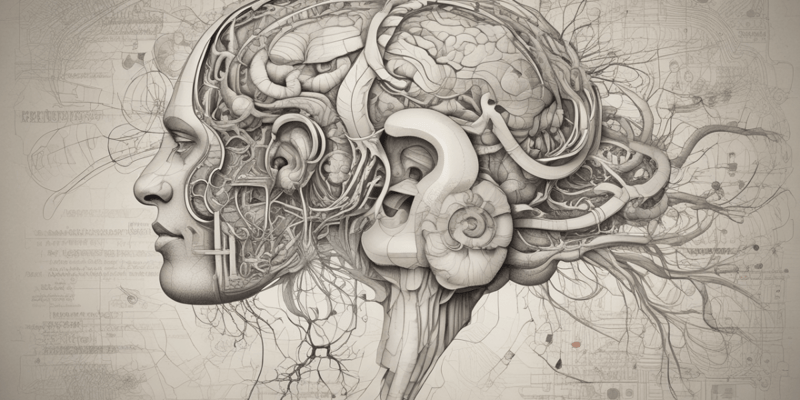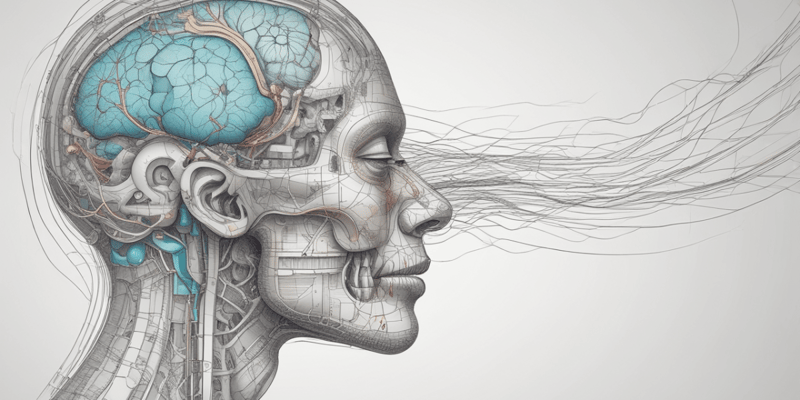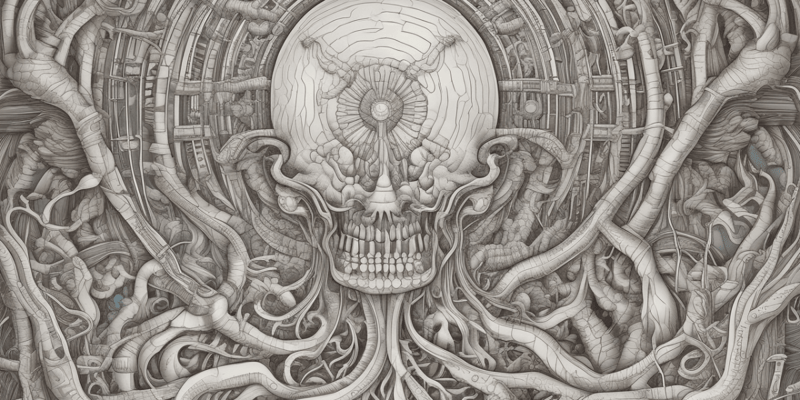Podcast
Questions and Answers
The olfactory pathway starts in the nasal cavity.
The olfactory pathway starts in the nasal cavity.
True
The olfactory receptors are located in the cribriform plate.
The olfactory receptors are located in the cribriform plate.
False
The olfactory nerve fibers terminate in the telencephalon.
The olfactory nerve fibers terminate in the telencephalon.
False
Tufted cells are the largest type of neurons in the olfactory bulb.
Tufted cells are the largest type of neurons in the olfactory bulb.
Signup and view all the answers
Mitral cells project axons into the medial olfactory striae.
Mitral cells project axons into the medial olfactory striae.
Signup and view all the answers
The anterior olfactory nucleus is located in the olfactory bulb.
The anterior olfactory nucleus is located in the olfactory bulb.
Signup and view all the answers
The lateral olfactory striae project axons into the contralateral olfactory bulb.
The lateral olfactory striae project axons into the contralateral olfactory bulb.
Signup and view all the answers
The olfactory tract is also known as the olfactory nerve.
The olfactory tract is also known as the olfactory nerve.
Signup and view all the answers
The primary olfactory cortex is located in the anterior commissure.
The primary olfactory cortex is located in the anterior commissure.
Signup and view all the answers
The olfactory tract reaches the anterior perforated substance and divides into lateral and medial olfactory striae.
The olfactory tract reaches the anterior perforated substance and divides into lateral and medial olfactory striae.
Signup and view all the answers
Taste pores are found on the dorsal surface of the tongue.
Taste pores are found on the dorsal surface of the tongue.
Signup and view all the answers
The olfactory pathway has three neurons before reaching the cerebral cortex.
The olfactory pathway has three neurons before reaching the cerebral cortex.
Signup and view all the answers
The entorhinal area is part of the parietal operculum.
The entorhinal area is part of the parietal operculum.
Signup and view all the answers
The piriform cortex is part of the primary olfactory cortex.
The piriform cortex is part of the primary olfactory cortex.
Signup and view all the answers
The orbitofrontal cortex is located on the upper side of the frontal lobe.
The orbitofrontal cortex is located on the upper side of the frontal lobe.
Signup and view all the answers
Lesions to the hypothalamus will result in an inability to distinguish different odors.
Lesions to the hypothalamus will result in an inability to distinguish different odors.
Signup and view all the answers
Taste buds are found on the dorsal surface of the tongue and contain taste cells and receptors.
Taste buds are found on the dorsal surface of the tongue and contain taste cells and receptors.
Signup and view all the answers
The primary taste area is located in the temporal lobe.
The primary taste area is located in the temporal lobe.
Signup and view all the answers
The hypothalamus is located at the dorsal part of the diencephalon.
The hypothalamus is located at the dorsal part of the diencephalon.
Signup and view all the answers
The hypothalamus controls body homeostasis through the somatic nervous system.
The hypothalamus controls body homeostasis through the somatic nervous system.
Signup and view all the answers
The hypothalamus plays a vital role in emotional behavior.
The hypothalamus plays a vital role in emotional behavior.
Signup and view all the answers
The hypothalamic sulcus separates the hypothalamus from the cerebral cortex.
The hypothalamic sulcus separates the hypothalamus from the cerebral cortex.
Signup and view all the answers
The hypothalamus is referred to as the head ganglion of the somatic nervous system.
The hypothalamus is referred to as the head ganglion of the somatic nervous system.
Signup and view all the answers
The lateral boundary of the hypothalamus is the 3rd ventricle.
The lateral boundary of the hypothalamus is the 3rd ventricle.
Signup and view all the answers
The hypothalamus stimulates somatic responses through connections with the brainstem.
The hypothalamus stimulates somatic responses through connections with the brainstem.
Signup and view all the answers
The hypothalamus influences visceral structures through its control over the spinal cord.
The hypothalamus influences visceral structures through its control over the spinal cord.
Signup and view all the answers
The hypothalamus affects autonomic motor neurons only directly.
The hypothalamus affects autonomic motor neurons only directly.
Signup and view all the answers
The limbic system is responsible for rational decision making and logical thinking.
The limbic system is responsible for rational decision making and logical thinking.
Signup and view all the answers
The infundibular or arcuate nucleus is responsible for producing luteinizing hormone-releasing hormone (LHRH) and follicle-stimulating hormone (FSH).
The infundibular or arcuate nucleus is responsible for producing luteinizing hormone-releasing hormone (LHRH) and follicle-stimulating hormone (FSH).
Signup and view all the answers
The hippocampal formation is a part of the allocortex/limbic cortex.
The hippocampal formation is a part of the allocortex/limbic cortex.
Signup and view all the answers
The paraventricular nuclei are responsible for regulating the sympathetic nervous system.
The paraventricular nuclei are responsible for regulating the sympathetic nervous system.
Signup and view all the answers
Stimulation of the posterior hypothalamic area can cause parasympathetic responses such as lowering blood pressure and slowing of heart rate.
Stimulation of the posterior hypothalamic area can cause parasympathetic responses such as lowering blood pressure and slowing of heart rate.
Signup and view all the answers
The parahippocampal gyrus is a part of the paralimbic area.
The parahippocampal gyrus is a part of the paralimbic area.
Signup and view all the answers
The amygdaloid nucleus is responsible for processing visual information.
The amygdaloid nucleus is responsible for processing visual information.
Signup and view all the answers
The hypothalamic regulatory hormone GHRH synthesizes vasopressin (antidiuretic hormone).
The hypothalamic regulatory hormone GHRH synthesizes vasopressin (antidiuretic hormone).
Signup and view all the answers
The limbic system is located in the lateral surface of the cerebral hemisphere.
The limbic system is located in the lateral surface of the cerebral hemisphere.
Signup and view all the answers
The hypothalamus regulates temperature, specifically in response to cold.
The hypothalamus regulates temperature, specifically in response to cold.
Signup and view all the answers
The mammillary bodies are a part of the limbic system.
The mammillary bodies are a part of the limbic system.
Signup and view all the answers
The hypothalamic regulatory hormone PRH is involved in the regulation of the parasympathetic system.
The hypothalamic regulatory hormone PRH is involved in the regulation of the parasympathetic system.
Signup and view all the answers
The anterior thalamic nucleus is a part of the corticoid area.
The anterior thalamic nucleus is a part of the corticoid area.
Signup and view all the answers
The hypothalamus has a role in initiating eating and increasing food intake (hunger center).
The hypothalamus has a role in initiating eating and increasing food intake (hunger center).
Signup and view all the answers
The hypothalamic regulatory hormone GHIH or Somatostatin synthesizes oxytocin.
The hypothalamic regulatory hormone GHIH or Somatostatin synthesizes oxytocin.
Signup and view all the answers
The cingulate gyrus is a part of the paralimbic area.
The cingulate gyrus is a part of the paralimbic area.
Signup and view all the answers
The limbic system is responsible for motor control and coordination.
The limbic system is responsible for motor control and coordination.
Signup and view all the answers
The hypothalamus regulates circadian rhythms.
The hypothalamus regulates circadian rhythms.
Signup and view all the answers




